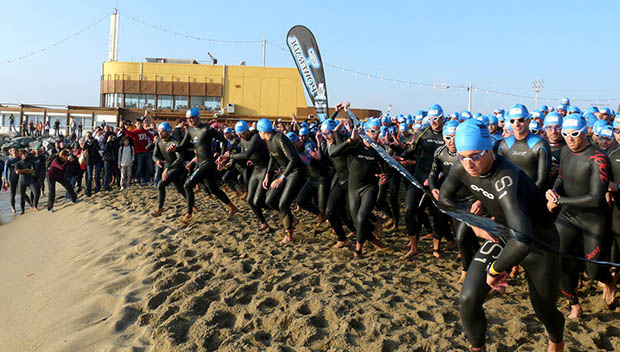
The biggest barrier to doing a triathlon is most often the swim. Swimming is not a skill every adult picked up as a kid at the community pool. Though it can look intimidating, you shouldn't let it stop you. Taking a swim class, finding the right gear and learning the basics of the swim leg of a triathlon can get you ready for your first race.
Training for the Race
Join a Swim Class
There are a lot of things you can teach yourself, but swimming should not be one of them. Why? Swimming is about stroke efficiency and getting the most out of every movement in the water. The best way to do this is to have someone show you the right techniques and watch your form. There is no shame in joining a local adult swim class that starts with swim basics like floating, breathing and kicking. After finding a class, the key is consistency, so be sure to practice at least three times a week. Swim classes focus on techniques for a pool that you can implement in a triathlon swim with a few differences.
Training for the Triathlon Swim
Every skill you learn in the pool is transferable to open water but has to be adjusted. Get comfortable with swimming in water that might be cloudy and filled with fish. There will also be a couple dozen people "in your lane," and breathing will not be as rhythmic at first.
So what are the technique differences from the pool to open water? The most important is your breathing. In the pool, you practice bilateral breathing--breathing to both the left and right side every three strokes. Breathing like this helps keep you balanced and straight but also gives you options in an open water swim. If the wind picks up and splashes water into your mouth on the right side, you can just breathe to the left.
Another difference is that any stroke is permissible in a triathlon swim, even doggie paddle or backstroke. Knowing that at any point you can turn to your back and float if you need to rest is comforting to many with anxiety in the water.
Lastly, practice sighting. Sighting is a technique used to keep you on course by using stationary objects in the distance for reference. There will not be any pool markers, black lines or ledges to keep you straight. You can look up as often as you need to tweak your direction.
Get the Correct Gear
Unlike cycling, there are only a few pieces of gear you really need for the swim. The most basic piece of equipment, besides your suit, is a pair of googles. It may take buying a few pairs to find the right ones; make sure they fit your face, do not give you an immediate headache and have the right glass tint. For swimming outdoors, you should have a slight tint and look for goggles that open up peripheral vision. You should always have two pairs of goggles with you, so once you find a pair you like, buy a few more in different tints. Other swim gear, such as fins, pull buoys and kickboards can help you get faster and practice technique but are not necessary.
- 1
- of
- 3








Discuss This Article